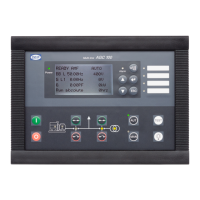7. Protections
7.1 General
7.1.1 General
The protections are all of the definite time type, i.e. a setpoint and time is selected.
If the function is e.g. overvoltage, the timer will be activated if the setpoint is exceeded. If the voltage value
falls below the setpoint value before the timer runs out, then the timer will be stopped and reset.
Setpoint
Time
Timer
start
Timer
reset
Timer
start
Alarm
Timer setting
Measured
value
When the timer runs out, the output is activated. The total delay will be the delay setting + the reaction time.
When parameterising the DEIF controller, the measuring class of the controller and an ade-
quate "safety" margin has to be taken into consideration.
An example:
A power generation system must not reconnect to a network when the voltage is 85% of Un
+/-0% < U < 110% +/-0%. In order to ensure reconnection within this interval, a control unit’s
tolerance/accuracy (Class 1 of the measuring range) has to be taken into consideration. It is
recommended to set a control unit’s setting range 1-2% higher/lower than the actual setpoint
if the tolerance of the interval is +/-0% to ensure that the power system does not reconnect
outside the interval.
Phase-neutral voltage trip
If the voltage alarms are to work based on phase-neutral measurements, please adjust menus 1200 and
1340 accordingly. Depending on the selections, either phase-phase voltages or phase-neutral voltages will be
used for the alarm monitoring.
AGC 100 Designer's Reference Handbook
4189340766 UK
Protections
DEIF A/S Page 106 of 152

